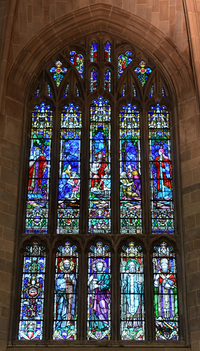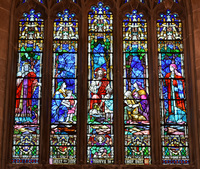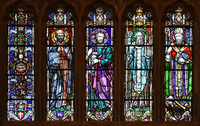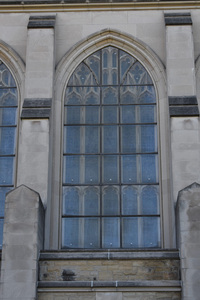Window
Building Name: Cathedral of the Most Blessed SacramentStudio Name: Willet Hauser Architectural Glass
City: Detroit
Window Shape: 6 (gothic arched, more than 2 vertical sections)
Subject/Title of Window: Christ Blessing the Little Children
Brief Description of Subject:
The canopy topping this five panel window is decorative in nature highlighted by angels with a censer.
The scene below is topped with decorative inscriptions based on Matt. 28:4-5 -- the resurrection scene where the two Mary's had come to anoint the body of Jesus and an angel appeared at the tomb "And for fear of him the guards trembled and became like dead men. But the angel said to the women 'Don't be afraid, for I know you seek Jesus.'" Christ Blessing the Little Children is covered in Matt.19:13-15. The Guide to the Cathedral of the Most Blessed Sacrament" gives an excellent description of this scene (see last paragraph). Just some comments. The inscription is written in archaic English; the word "suffer" means "let" in modern English thus would read "Let the little children come unto me". The two male figures in the outer panels were identified as the Apostles Peter and John. It is unusual that they do not have a saints nimbus however some artists do not put a saint's nimbus on an Apostle until after Pentecost. Below the scene are decorative coats-of-arms as befitting a Norman styled church as well as an angel holding what to me looks like an eagle -- an eagle symbolizes renewal of youth.
In the lower portion of this window is found four saints with the artist's creation of their coat-of-arms as well as a decorative panel.
First panel is decorative in nature with Christian icons and inscribed "Praise HIM".
St. Philip Neri (1515-1595) was an important figure in the Counter-Reformation and is known as the "Apostle of Rome". He became a priest and founded the "Congregation of the Oratory of St. Philip Neri" which is a community of priests and lay members devoted to charity. He preached the gifts of the Holy Spirit as well as the Eucharist and had a particularly strong devotion to the Virgin Mary. His attributes seen here a biretta (priest), dressed as an Oratorian, Rosary, and a book (preacher). The coat of arms seen here is that of St. Boniface.
St. Philip was one of the Apostles and mainly known as the first Apostle to realize that Jesus was the one written about in the Old Testament (John 1:45) and was the first to alert Jesus that they had not brought enough food to feed the multitude that had assembled to hear Him preach -- this lead to the "Miracle of the Loaves and Fishes". His attributes seen here are a scroll (Holy Wisdom), a processional staff (follower of Christ), and three loaves of bread in his coat-of-arms.
St. Athanasius the Great (298-373) was a Bishop of Alexandria and one of the Greek Fathers of the Church. He was a participant in the Council of Nicaea and staunch defender of the Holy Trinity. His attributes seen here include costumed as a Bishop, a crozier, and in the coat-of-arms a scroll (wisdom) and a luminous triangle (Trinity). I was not able to identify the church that he is holding.
St. Boniface (671-754) was born in Anglo-Saxon England and is known as one of the greatest missionaries of Germania. He was appointed bishop for all of Germania by Pope Gregory II. One of the more famous stories about St. Boniface relates how he used an ax to chop down an oak tree considered sacred by pagans, when their god did no harm to him they converted to Christianity. He was martyred while preaching in Friesland; a legend grew up that when he was attacked he raised a Book of the Gospels to defend himself however the attacker's sword went through the book killing St. Boniface. His attributes seen here are dressed as a bishop holding a crosier, holding a book pierced with a sword, and an ax at his feet. The coat-of-arms contains a bunch of grapes (Holy Eucharist); I can only guess that this was intended for St. Philip of Neri as he championed the Holy Eucharist.
From the Guide to the Cathedral of the Most Blessed Sacrament, Copyright 1958, Archdiocese of Detroit.
On one occasion the women of the country in which Christ was preaching pressed their children upon Him that they might receive His blessing. When the Apostles tried to restrain them, the Master rebuked them. The first part of these words form the text of the window. In the center is Christ and to his left and right can be seen the children and their delighted mothers. St. Peter is in the extreme left panel and St. John at the extreme right. Beneath are St. Philip Neri, St. Philip the Apostle, St. Athanasius, and St. Boniface.
Inscriptions: Suffer the little children to come unto Me
Height: 25'
Width: 12'
Christ Blessing the Children
Christ Blessing the Children scene
Christ Blessing the Children, Saints
Christ Blessing the Children outside
The MSGC is a constantly evolving database. Not all the data that has been collected by volunteers has been sorted and entered. Not every building has been completely documented.
All images in the Index are either born-digital photographs of windows or buildings or are scans of slides, prints, or other published sources. These images have been provided by volunteers and the quality of the material varies widely.
If you have any questions, additions or corrections, or think you can provide better images and are willing to share them, please contact donald20@msu.edu






